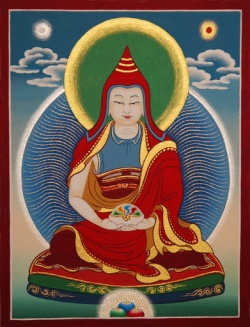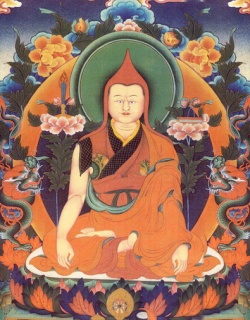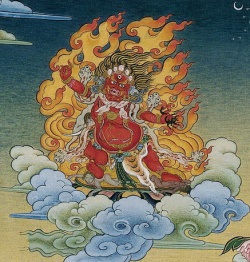Difference between revisions of "A Guide to Locations for Cultivating Samadhi"
| Line 1: | Line 1: | ||
[[File:Vimalamitra554.jpg|thumb|250px|]] | [[File:Vimalamitra554.jpg|thumb|250px|]] | ||
| + | |||
| + | |||
| + | |||
| + | |||
| + | |||
| + | |||
| + | |||
| + | |||
<poem> | <poem> | ||
by [[Longchen Rabjam]] | by [[Longchen Rabjam]] | ||
| − | On mountaintops, in secluded forests and on islands and the like, | + | On mountaintops, in secluded [[forests]] and on islands and the like, |
Places which are [[agreeable]] to the [[mind]] and well suited to the season, | Places which are [[agreeable]] to the [[mind]] and well suited to the season, | ||
Cultivate [[tranquil]] [[samadhi]], which is [[single-pointed]] and unwavering— | Cultivate [[tranquil]] [[samadhi]], which is [[single-pointed]] and unwavering— | ||
| Line 21: | Line 29: | ||
[[File:LONGCHEPA3.jpg|thumb|250px|]] | [[File:LONGCHEPA3.jpg|thumb|250px|]] | ||
In the spring, stay in the [[mountains]] or on the edges of a {{Wiki|forest}}, | In the spring, stay in the [[mountains]] or on the edges of a {{Wiki|forest}}, | ||
| − | On a deserted island or in buildings with mild and even temperature, | + | On a deserted [[island]] or in buildings with mild and even temperature, |
With [[diet]], clothing and conduct all suitably attuned—this is crucially important. | With [[diet]], clothing and conduct all suitably attuned—this is crucially important. | ||
There is an important interconnection between outer and inner, | There is an important interconnection between outer and inner, | ||
| Line 29: | Line 37: | ||
Snowy regions help to make [[samadhi]] clear and [[awareness]] bright and lucid, | Snowy regions help to make [[samadhi]] clear and [[awareness]] bright and lucid, | ||
So for [[cultivating]] [[vipashyana]] they make {{Wiki|ideal}} places with the fewest {{Wiki|obstacles}}. | So for [[cultivating]] [[vipashyana]] they make {{Wiki|ideal}} places with the fewest {{Wiki|obstacles}}. | ||
| − | Forests bring stillness of [[mind]] and help us to develop [[mental]] stability, | + | [[Forests]] bring stillness of [[mind]] and help us to develop [[mental]] stability, |
So they are {{Wiki|ideal}} places for [[cultivating]] [[shamatha]] with a [[sense]] of ease. | So they are {{Wiki|ideal}} places for [[cultivating]] [[shamatha]] with a [[sense]] of ease. | ||
Below rocky cliffs we can [[feel]] a vivid [[sense]] of [[impermanence]] and disenchantment, | Below rocky cliffs we can [[feel]] a vivid [[sense]] of [[impermanence]] and disenchantment, | ||
| Line 49: | Line 57: | ||
Contribute, it is believed, to [[mental]] turmoil and bring all [[manner]] of {{Wiki|obstacles}}. | Contribute, it is believed, to [[mental]] turmoil and bring all [[manner]] of {{Wiki|obstacles}}. | ||
The lands of {{Wiki|outcastes}}, [[nagas]], [[nyen]], and local [[spirits]], | The lands of {{Wiki|outcastes}}, [[nagas]], [[nyen]], and local [[spirits]], | ||
| − | By the lakeside, or in meadows, forests and such places, | + | By the lakeside, or in meadows, [[forests]] and such places, |
Adorned with beautiful [[flowers]], [[plants]] and [[trees]], | Adorned with beautiful [[flowers]], [[plants]] and [[trees]], | ||
Are [[pleasant]] enough at first, but later prove disruptive. | Are [[pleasant]] enough at first, but later prove disruptive. | ||
| Line 76: | Line 84: | ||
For nighttime [[yoga]], practise inside a circular ‘dark house’, | For nighttime [[yoga]], practise inside a circular ‘dark house’, | ||
In a high place, and in the middle of the central chamber, | In a high place, and in the middle of the central chamber, | ||
| − | With your pillow to the [[north]], lying down in the [[posture]] of [[nirvana]]. | + | With your pillow to the [[north]], {{Wiki|lying}} down in the [[posture]] of [[nirvana]]. |
The location for practising the [[yoga]] of [[light]] during the daytime, | The location for practising the [[yoga]] of [[light]] during the daytime, | ||
Should be mild in temperature and should have an entrance | Should be mild in temperature and should have an entrance | ||
| − | With a broad, unobstructed [[view]] onto {{Wiki|glaciers}}, waterfalls, forests or valleys, | + | With a broad, unobstructed [[view]] onto {{Wiki|glaciers}}, waterfalls, [[forests]] or valleys, |
And the vast and open sky, so that [[mind]] becomes clear and bright. | And the vast and open sky, so that [[mind]] becomes clear and bright. | ||
When [[cultivating]] [[shamatha]], a {{Wiki|solitary}} hut surrounded by a fence | When [[cultivating]] [[shamatha]], a {{Wiki|solitary}} hut surrounded by a fence | ||
| Line 85: | Line 93: | ||
For [[vipashyana]], it is important to have a clear, inspiring [[view]], | For [[vipashyana]], it is important to have a clear, inspiring [[view]], | ||
And to be constantly cheerful and well attuned to the seasons. | And to be constantly cheerful and well attuned to the seasons. | ||
| − | Low-lying and shaded areas, such as forests and ravines, | + | Low-lying and shaded areas, such as [[forests]] and ravines, |
Are {{Wiki|ideal}} for practising [[shamatha]], whereas higher regions, | Are {{Wiki|ideal}} for practising [[shamatha]], whereas higher regions, | ||
Such as among snowy [[mountains]], are {{Wiki|ideal}} for [[vipashyana]]— | Such as among snowy [[mountains]], are {{Wiki|ideal}} for [[vipashyana]]— | ||
| Line 94: | Line 102: | ||
Is said to be the {{Wiki|equal}} of the [[sacred]] site of the [[heart]] of [[awakening]]. | Is said to be the {{Wiki|equal}} of the [[sacred]] site of the [[heart]] of [[awakening]]. | ||
Whereas any place in which [[virtues]] {{Wiki|decline}}, [[mental]] [[afflictions]] {{Wiki|increase}}, | Whereas any place in which [[virtues]] {{Wiki|decline}}, [[mental]] [[afflictions]] {{Wiki|increase}}, | ||
| − | And one is overcome by distractions and the affairs of this [[life]], | + | And one is overcome by {{Wiki|distractions}} and the affairs of this [[life]], |
Is a {{Wiki|demonic}} haunt of [[evil]] [[actions]], only to be avoided by the [[wise]]. | Is a {{Wiki|demonic}} haunt of [[evil]] [[actions]], only to be avoided by the [[wise]]. | ||
| − | Since these points were taught by [[Padmasambhava]], | + | Since these points were [[taught]] by [[Padmasambhava]], |
They should be learned by all who wish for [[liberation]]. | They should be learned by all who wish for [[liberation]]. | ||
This concludes the first section, being an explanation of the locations for [[cultivating]] [[samadhi]], from ‘[[Finding Comfort and Ease in Meditation]] on the [[Great Perfection]]’. | This concludes the first section, being an explanation of the locations for [[cultivating]] [[samadhi]], from ‘[[Finding Comfort and Ease in Meditation]] on the [[Great Perfection]]’. | ||
| − | | Translated by Adam Pearcey, [[Rigpa]] Translations, based on an earlier, unpublished translation of [[Finding Comfort and Ease in Meditation]] on the [[Great Perfection]] by B. {{Wiki|Alan Wallace}} and Adam Pearcey, prepared for HH the [[Dalai Lama’s]] teachings in [[Lerab Gar]], {{Wiki|France}}, 2000. | + | | Translated by [[Adam Pearcey]], [[Rigpa]] Translations, based on an earlier, unpublished translation of [[Finding Comfort and Ease in Meditation]] on the [[Great Perfection]] by B. {{Wiki|Alan Wallace}} and [[Adam Pearcey]], prepared for HH the [[Dalai Lama’s]] teachings in [[Lerab Gar]], {{Wiki|France}}, 2000. |
</poem> | </poem> | ||
{{R}} | {{R}} | ||
Latest revision as of 18:29, 30 March 2024
by Longchen Rabjam
On mountaintops, in secluded forests and on islands and the like,
Places which are agreeable to the mind and well suited to the season,
Cultivate tranquil samadhi, which is single-pointed and unwavering—
Clear light, which is free from the slightest conceptual elaboration.
This is achieved naturally when three pure factors come together:
The ideal location, individual and Dharma to be practised.
First of all, the location must be one that is secluded and agreeable,
Somewhere conducive to spiritual practice in the different seasons.
In summer, meditate in cooler dwellings and cooler locations,
In places near to glaciers or on mountaintops and the like,
In simple dwellings made out of reeds, bamboo or straw.
In the autumn, adjust your diet, your clothing, and your conduct,
And stay in a region and residence of moderate temperature,
Such as a forest or a mountainside or a building made of stone.
In winter, stay somewhere warmer at a lower altitude,
Such as a forest, a rocky cave or a hollow in the earthd adjust your diet, clothing, bedding and the rest.
In the spring, stay in the mountains or on the edges of a forest,
On a deserted island or in buildings with mild and even temperature,
With diet, clothing and conduct all suitably attuned—this is crucially important.
There is an important interconnection between outer and inner,
So keep to inspiring and secluded places which you find uplifting.
High among the mountains the mind becomes clear and expansive,
Ideal for refreshing mental dullness and for practising the generation phase.
Snowy regions help to make samadhi clear and awareness bright and lucid,
So for cultivating vipashyana they make ideal places with the fewest obstacles.
Forests bring stillness of mind and help us to develop mental stability,
So they are ideal places for cultivating shamatha with a sense of ease.
Below rocky cliffs we can feel a vivid sense of impermanence and disenchantment,
Clear and inspired, helping us to achieve the union of shamatha and vipashyana.
On the banks of a river, our attention becomes well focused,
And the wish to escape samsara comes rapidly and afresh.
Charnel grounds are powerful places for swift accomplishment,
Ideal for the generation or completion phases, it is said.
Villages, markets, empty houses, solitary trees and the like, Which are frequented by humans and non-human demons,
Are distracting for beginners and can bring many obstacles,
But for stable practitioners, they are a support, regarded as supreme.
Temples and shrines, inhabited by gyalpo and gongpo spirits,
Can disturb the mind and incite thoughts of anger and aversion.
Caverns in the earth and such places, haunted by the senmo demonesses,
Cause passionate desire to arise and bring excessive dullness and agitation.
Solitary trees and other places, which are inhabited by mamos and dakinis,
As well as boulders and mountain spurs, where the mutsen and theu'rang reside,
Contribute, it is believed, to mental turmoil and bring all manner of obstacles.
The lands of outcastes, nagas, nyen, and local spirits,
By the lakeside, or in meadows, forests and such places,
Adorned with beautiful flowers, plants and trees,
Are pleasant enough at first, but later prove disruptive.
In short, all the areas and dwelling places that seem agreeable at first,
But not so once you come to know them, are sites of lesser accomplishment.
Whereas those which seem frightening and unpleasant at first,
But prove agreeable once you have grown accustomed to them,
Are powerfully transformative, bringing great accomplishments without obstacle.
And everywhere else in between is neutral, neither beneficial nor harmful.
As our minds are affected by the places in which we stay,
This can make our practice grow stronger or make it weaker,
So it is said that to examine locations is of crucial importance.
Moreover, there are four types of place based on the four activities:
Peaceful places, where mind naturally becomes focused and still,
Expansive places, delighting the mind, which are awesome and inspiring,
Magnetizing places, where mind feels captivated and develops attachment,
And wrathful places, where mind is disturbed by feelings of fear and dread.
Further divisions can be made, countless and beyond measure,
But in this context, for samadhi, peaceful places are the best,
And so, fearing an excess of words, I will elaborate no further.
In such a peaceful place, the meditation dwelling should be in solitude,
As this will suit the development of concentration in the mind.
The ideal dwelling is one that is open at the sides and has a clear view.
For nighttime yoga, practise inside a circular ‘dark house’,
In a high place, and in the middle of the central chamber,
With your pillow to the north, lying down in the posture of nirvana.
The location for practising the yoga of light during the daytime,
Should be mild in temperature and should have an entrance
With a broad, unobstructed view onto glaciers, waterfalls, forests or valleys,
And the vast and open sky, so that mind becomes clear and bright.
When cultivating shamatha, a solitary hut surrounded by a fence
Is the ideal place for stillness of mind naturally to arise.
For vipashyana, it is important to have a clear, inspiring view,
And to be constantly cheerful and well attuned to the seasons.
Low-lying and shaded areas, such as forests and ravines,
Are ideal for practising shamatha, whereas higher regions,
Such as among snowy mountains, are ideal for vipashyana—
It is important that you know these different specifications.
To put it simply, any region or actual dwelling place for retreat,
In which renunciation and disenchantment arise, attention is well focused,
And samadhi grows in strength—any such place of virtuous activity—
Is said to be the equal of the sacred site of the heart of awakening.
Whereas any place in which virtues decline, mental afflictions increase,
And one is overcome by distractions and the affairs of this life,
Is a demonic haunt of evil actions, only to be avoided by the wise.
Since these points were taught by Padmasambhava,
They should be learned by all who wish for liberation.
This concludes the first section, being an explanation of the locations for cultivating samadhi, from ‘Finding Comfort and Ease in Meditation on the Great Perfection’.
| Translated by Adam Pearcey, Rigpa Translations, based on an earlier, unpublished translation of Finding Comfort and Ease in Meditation on the Great Perfection by B. Alan Wallace and Adam Pearcey, prepared for HH the Dalai Lama’s teachings in Lerab Gar, France, 2000.




